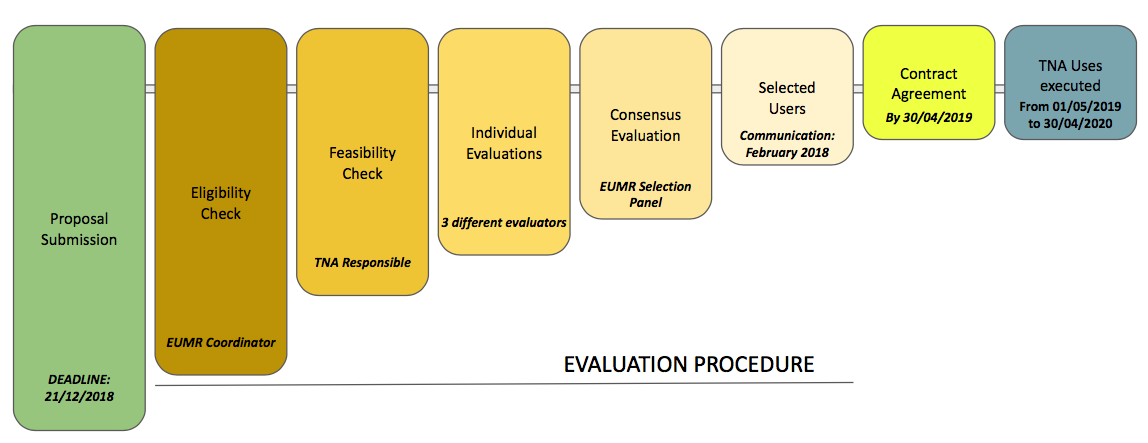Second TNA Call Closed
Our proposal is to build a network of marine robotics RIs to help ensure that the EU remains a world-leader in ocean science and engineering, with a thriving maritime industry. The proposed RI will enable, expand and reduce risk of access to next-generation marine robotics technologies and operational expertise and will build confidence in end-users to accelerate the adoption of next-generation marine robotics for the marine sector as a whole.
To do so we will have a series of Trans-national access activities (TNA) with the focus of:
- providing a coherent framework for stakeholders to gain access to both the “standard” and the “developing” capacities of the RI providing access to appropriate levels of training and best-practices, to build sustainability by educating the next generation of practitioners
- providing access to experimental activities proposed by external partners or use-cases that are chosen to provide a broad cross-section of experimental opportunities for end-users
Through all this EUMarineRobots is making available a huge range of marine robotic and support infrastructure with a capital value of well in-excess of €500M and its associated support personnel.
Previous Calls Applicants
Calendar
| Call Open | May 14, 2019 |
| Call Deadline | |
| Notification of Results | October, 2019 |
| Access | November 2019 - December 2020 |
Who can apply?
 |
 |
 |
| Students school students, undergraduate, graduate, PhD, Master |
Industrial researchers and Academics including postdoctoral |
Entrepreneurs Micro and SMEs, Mid-Caps, Large industries. |
Proposals for access to any of the offered infrastructures need to fulfill the following criteria:
- The Principal Investigator (PI) and the majority of the users must work in an institution established in a member state of the European Union or state associated to H2020 Programme. Other countries can apply but their allocated uses will be limited to a maximum of 20% of all allocated uses.
- The PI of a project and the majority of the users must work in a country other than the country where the infrastructure is based. They cannot apply for use time on a research infrastructure from their own country.
- Proposals must involve at least one partner. A larger partnership will be highly appreciated, for the embarked scientific party as for data treatment and exploitation but the funding will be awarded per access, independently of the number of participating institutions.
- Collaborative applications from teams and institutions with limited or no access to marine infrastructure are strongly encouraged.
- Applicants must be aware that, if granted, they must complete the training associated to the usage of the infrastructure they have applied for.
- Only user groups that are entitled to and willing to disseminate the knowledge they will generate under the project are eligible to benefit from access free of charge to the infrastructures under the EUMR flag.
How to apply?
Proposal submission involves five steps, as outlined below. Proposals have to be submitted online via the project website:
- Step 1: Download your applicant package. There, you will find: the Proposal Application Template that will need to be completed, the Guidelines for Applicants and the Report template (to be filled out after the completion of the use, if awarded).
- Step 2: Prepare your proposal offline based on the provided template.
- Step 3: Complete the online application form and upload the proposal application template.
The document must:
- be an unprotected pdf file of maximum 8 pages
- not exceed 4MB in size
- follow the given format
- Step 4: The evaluation of proposals will be based upon the information provided in the completed application form, which should be correct, sufficient and adequate for this purpose, taking into consideration the evaluation criteria outlined below.
Selected participants will later be asked to fill the Contract Agreement Model that can be consulted here.
Selection Process
The EUMR User Selection Panel established by the EUMR Consortium consisting of 5 to 10 international experts covering all fields of marine robotics and project representatives, will judge eligible proposals based on the evaluation of each proposal by at least three independent reviewers. All reasonable measures will be taken to ensure Objectivity, Transparency, Equality of Treatment, Impartiality, Quality and Confidentiality.
The evaluation of proposals is managed by the EUMR Coordinator. The process aims to be fair and transparent and will provide constructive feedback to applicants
Evaluation is conducted in four steps, as follows:
| Step | Undertaken by |
|---|---|
| 1. Eligibility Check | EUMR Coordinator |
| 2. Feasibility Check | TNA access provider |
| 3. Individual Evaluations | Evaluators, overseen by the EUMR coordinator |
| 4. Consensus Evaluations | User Selection Panel |

Evaluation criteria
Eligible proposals will be evaluated using the following criteria.
|
Criteria |
Weighting |
|
30% |
|
25% |
|
10% |
|
10% |
|
15% |
|
10% |
Applicants must ensure that sufficient information is provided in the proposal to enable a thorough evaluation of all criteria
